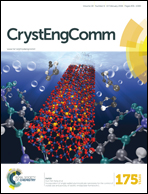A family of Zn(ii)/Cd(ii) halide systems incorporating 5,5′-di(pyridin-2-yl)-3,3′-bi(1,2,4-triazole)†
Abstract
By using 5,5′-di(pyridin-2-yl)-3,3′-bi(1,2,4-triazole) (2,2′-H2dbpt) as a building block, six new coordination complexes: Zn3(2,2′-Hdbpt)2(H2O)Cl4 (1), {[Zn2(2,2′-dbpt)Cl3]·Et3NH}n (2), {[Cd3Cl3(2,2′-dbpt)3]·2H2O}n (3), {[Cd3I3(2,2′-dbpt)3]·H2O}n (4), {[Cd2Br2(2,2′-dbpt)]·H2O}n (5), and [Cd2I4(2,2′-H2dbpt)]n (6), based on the M(II)/X (M = Zn, Cd; X = Cl, Br, I) system were generated. 1 and 2 bear a Zn3 supermolecule and a 1D wave-like chain, respectively. 3 and 4 are isostructural, giving a new 3D architecture with a (412·63) topology based on the [Cd6] ring as a node bridged by the μ2-Cl− ion and the μ2-I− ion, respectively. 5 is a 2D framework with a (32·62·72) topology based on the [Cd4] subunit. 6 reveals a 1D modified trapezoid chain with a (42·6) topology based on the trans-bridging 2,2′-H2dbpt. Based on the interesting structural results, the solid-state luminescence properties of complexes 1–6 were investigated, which revealed that the emission maximum wavelengths can be tuned in a large range of 403–498 nm. These results indicate that 2,2′-H2dbpt is not only an excellent building block to construct coordination complexes with interesting structures but also a good precursor to construct potential photoactive materials.


 Please wait while we load your content...
Please wait while we load your content...